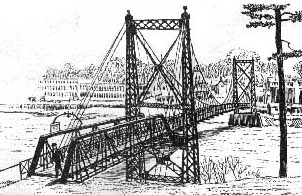 |
Kotlas - Waterville Area Sister City Connection P.O. Box 1747 Waterville, ME 04903-1747 Write to Us |
 |
Home > Impressions > Summer 1996
![[Show table of contents & options]](../../questionsign.gif) |
If you are viewing this newsletter without the table of contents, click the question mark sign anywhere that it appears to display the table of contents and other options. |
We Make the Kotlas Connection!
Fifteen intrepid travelers left on August 3, 1996 to visit our sister city, Kotlas, Russia. The group comprised Kotlas Connection members Earl and Mary Coombs, Jack and Pauline Mayhew, John and Ruth Engle, Jan and Mike Whitcomb, Phil Gonyar, Pat Hanson, Greg Smith and Vivian Tinner. The other participants were Barbara Bristow and Paula McAfee, teachers from Bangor, and Judy Adair, a teacher from Oklahoma.
Mary Coombs was the leader and organizer of the trip and guided us through many obstacles from obtaining the necessary paperwork to getting us on a plane when we still possessed no tickets on the departure day. We all owe her a great deal of thanks.
After one day of touring Moscow we were met by some of the Waterville Committee [i.e., the sister city committee in Kotlas] who had come down by train to escort us back to Kotlas. At the train station in Kotlas we were met by a large group of people who ran to greet the train. Many of them had tears in their eyes as they saw their pen pals and embraced them.
At this point each of us went to our individual families and had different experiences. I have asked people to share particular highlights or memories of the trip.
by Vivian Tinner
Besides the written reminiscences below, this newsletter also includes three photo essays: Music, Song, and Dance, Children, and People and Places.
![[Show table of contents & options]](../../questionsign.gif) |
A Kotlas Kaleidoscope |
As a first time visitor to Russia and Kotlas, I was not sure what to expect. I didn't know who I was going to stay with and I spoke very little Russian.
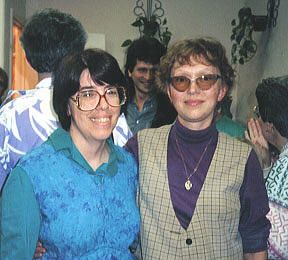 Vivian Tinner (L) and Lyuda Ugryumova. Photo by Jack or Pauline Mayhew. |
When the train pulled into the Kotlas station my stomach tightened with anxiety as I waited to see who would meet me. People met and embraced all around and I began to feel like the last kid picked for a grade school game of softball when a young woman wearing '60's style tinted glasses came up, hugged me and gave me a bouquet of flowers. She introduced herself as Lyudmilla [Ugryumova], the children's librarian at the Kotlas library. The first thing we discovered was that neither one of us spoke very much of the other's language.
At her home a welcoming celebration awaited me. I met her husband Viktor who works on train engines and her 19-year-old son Sasha who was studying electrical engineering in the Railroad University. A close friend Zoya, a dentist, completed the group. Despite the language barrier, they made me feel enveloped in a warm cocoon of welcoming and caring. Lyudmilla and I found out that we had similar personalities and did not mind pointing to words in the dictionary and acting out the meanings. I was impressed with the unreserved warmth from everyone.
We attended many events while I was there, but one of my main interests is nature, and I was curious to see what plants and animals we had in common and which were different. I had noted from the train window that many of the plants were the same ones we have in this area of Maine.
My family lived in one of the large, cement apartment houses common in Russia, so we didn't have much opportunity during the week to see many plants. My big opportunity came on the weekend which is typically the time city dwellers visit their dachas. The dacha is the summer house which is surrounded by the market gardens. Most people get their food supply from here as well as the surrounding woodlands. The Russians are very aware of their dependence on and connection to the land.
Lyudmilla told me that much of the area around the village is designated a "green area" and that is where the people from the village can gather mushrooms, cranberries, blueberries and other plants for medicine and food. I was very keen on going mushroom hunting, because I wanted to see what kinds were there.
We had to cover ourselves from head to toe, because, I was told, two of the villagers had gotten sick from insect bites. (I assumed they meant ticks.) The plants growing along the edge of the woods were basically familiar ones. We had fun identifying and sharing information about different ones.
The most amazing difference became apparent to me once we stepped into the woods. The entire ground was covered with the lichen which we call reindeer moss, giving it the appearance of being snow-covered. (Reindeer moss is a shrubby, grayish white lichen that usually grows 1½" high). Here it grew in great sponge-like clumps, providing soft cushioning for our feet. There was no underbrush, just evergreens with no lower branches, which gave it a park-like appearance. The soft springy "moss" continued as far as I could see. As we walked soundlessly through the woodland, I wondered where to find mushrooms in such an unfamiliar landscape. They were literally hidden under the reindeer moss and one had to watch for glimpses of russet, brown or gold peeking out from under it. The golden one they called "the fox" because of its color and it was the only one which looked familiar to me (similar to a chanterelle.) We gathered a colorful basketful of different varieties which were made into a delicious mushroom soup and a stick to the ribs dish of mushrooms, onions and potatoes when we returned to the dacha.
All of my meals consisted of freshly harvested and freshly made food as there are no supermarkets. Basically everything is grown and harvested locally. There is an open-air market where those who can't get to the forest or dacha can purchase fresh items. I really enjoyed the meals because even the staples such as potatoes were served in creative ways with different herbs. It was fun to participate in adding to the family larder.
After we had said tearful goodbyes to our families and were on the train heading north, it gave me a good feeling to look at small villages through the windows and know that I had gained some idea of the flow of Russian life within them.
by Vivian Tinner
![[Show table of contents & options]](../../questionsign.gif) |
A Special Church Service in a Small Town |
This was our fourth visit to Kotlas and as the train approached, I began to recognize familiar scenes — the outstretched, newly cut fields ,the river crossing, and the outlying Kotlas train station where we had arrived three years ago.
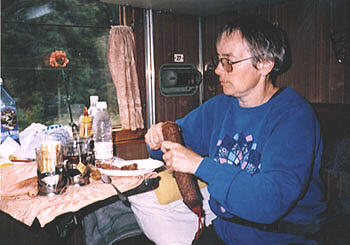 Mary Coombs prepares her lunch while riding to Kotlas. Photo by Jack or Pauline Mayhew. |
The trip from Moscow had taken 27 hours. We had been very comfortable in our compartments, visiting back and forth, drinking chai (Russian tea) and eating all we could hold! Zina Yegorova and Slava and Galina Chernykh had met us in Moscow with the tickets that made possible our journey to their city in the north. (Zina Yegorova and Slava Chernykh were members of the first Kotlas delegation to come to Waterville, in June 1990. Yegorova returned to Waterville for two weeks in in fall of 1998.) We shared news from both of our countries until late into the night.
Our group had practiced singing "Moscow Nights" in Russian because we had promised, on our last trip, that we would not return until we could do it and we wanted to keep our word. We also practiced some American songs to share and taught the macarena to all who were crazy enough to learn. The train station was filled with families who had come to pick us up. They smiled at all the American luggage for we are not known for traveling light! Suitcases brimmed with food, packages, pen pal letters and gifts. Oh yes, there were a few clothes to tide us over. People gave us flowers and bread, the symbol of Russian hospitality. For some of us it was the first trip, for others it was a homecoming. We had already met with Anya Yegorova, our "Russian daughter", in Moscow. At the Kotlas station we were met by our first Russian daughter, Yelena Vologdina. (Yelena and Anya were exchange students at Winslow High in 1992 and 1993-94, respectively. Both stayed with the Coombses.)
While there are many stories to relate about our stay, the renewal of old acquaintances and the making of new friends always remains the highlight. Elsewhere in this newsletter many stories will be shared with you. Each is as fresh in our minds as if we had been there yesterday. Kotlas is just that special of a place.
I would like to share our trip to Turovets, a small town up river from Kotlas. It is a place which we had never visited before. Please forgive me if all the details are not exactly correct because I have no way to check them but it is the "flavor" I am trying to bring you as I remember this special occasion.
We were fortunate to have a river boat captain, Yuri Chepurda, who was willing to take us there on his day off. We left with Zina's family and the Chepurdas at noon and after an hour on the river, with stops to take on and put off passengers, we arrived. We were picked up by cars which followed a tiny, paved road to a wooded area where there was a church. It was an old wooden, Russian Orthodox, tan with a green roof and blue onion dome. There was a summer church and a winter church, which is fairly common in Russia. The winter church is sometimes an upstairs room in the summer church and sometimes a smaller, separate building. It is very practical as there is usually less attendance in the winter; thus there is a smaller area to heat. The priest's home and garden were nearby. Here we met John and Ruth Engle, who had eaten dinner with the priest and his wife.
![[Show table of contents & options]](../../questionsign.gif)
Crowds of people stood everywhere. Babushki, or grandmothers, with shawls lined the benches outside the church. Inside the larger, summer church the ceremonial mass was in progress. It had been going on since sunrise. We purchased candles and followed the prayers listening to the chants of the hidden choir.
 Earl Coombs (R) wades into the healing stream with two unidentified Russians. Photo by Mary Coombs. |
This was a special day for the Russians. It was the anniversary of a miracle that had occurred long ago. The Virgin Mary had appeared in a clearing behind the church. The blessed icon (of the Virgin) would be unveiled and taken to the same clearing for a special ceremony later. On this one day every year the land was considered holy. The water in the small river which ran behind the was believed to have healing powers and the spring water was considered to be holy. We made our way to the spring to collect water and then down to the river where we walked into the freezing water [that was said] to cure arthritis.
As we made our way back up the hillside, we came to the clearing where the procession was just arriving. Two young ,bearded, elaborately robed priests led the group. Banners, held proudly by honored, elder ladies, followed behind them. One priest carried the Russian crucifix and the other the Blessed Icon.
They stopped beneath a special fir tree that had eight serrate points — part of the miracle of the clearing. Prayers were said and chanting continued for a long time. Everyone was hushed. A special feeling came over us. Toward the end the priest welcomed everyone who had come to celebrate this special event and mentioned, especially, the American visitors. I had wondered if they would feel that we were outsiders and resent our being there. However, they smiled and many said that we were the first Americans that they had ever seen. They were glad we were there to share this holy day with them.
As we each left the woods to follow the path back to the church, we kissed the icon, went under it, kissed the feet of Jesus on the cross and then were doused with holy water. (I truly mean doused. The priest took great delight in reminding everyone to lead a holy life!)
It was a very interesting experience for me. I have been in many Orthodox churches and seen the icons, attended some ceremonies and saw a wedding but I have never felt quite like this. I felt it was a true picture of Russian life and I felt privileged to have had this opportunity to see their faith in a new light.
You can take tours to Russia anytime and you can see the marvelous artwork and buildings in Moscow and St. Petersburg but the true heart and wealth of the people lie outside its cities. We have been fortunate to have caught an essence of that strength that has sustained them throughout the ages. Our ties to Russia and Kotlas are "with the earth."
by Mary Coombs
For more pictures by Mary & Earl Coombs, see the photo displays "Music, Song, and Dance" and "People and Places".
![[Show table of contents & options]](../../questionsign.gif) |
Kotlas Memories |
It was exciting to see our hosts, Irina and Grisha Reznichenko, at the railroad station as we arrived in Kotlas for our second visit. (The Mayhews, in turn, hosted Irina Reznichenko when she, Zina Yegorova, and two others came to the Waterville area in the fall of 1998.) The welcome was both heart-warming and a relief after the long flight and train ride. Our host family, close circle of friends and the good citizens of Kotlas extended their customary hospitality.
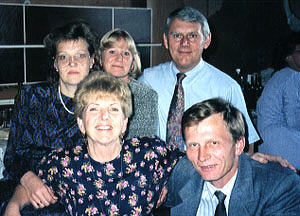 Clockwise from top left: Irina Reznichenko, Lyuba Zinovkina, Jack Mayhew, Grisha Reznichenko, and Pauline Mayhew. |
We were anxious to talk with our friends and catch up on events in their lives over the last few years. The first thing we noticed was how much the children had grown. Our host family had made significant changes in their apartment with new wallpaper, paint, and a newly remodeled bathroom.
Although we didn't expect to be as busy as we had been on our previous visit several functions had been set up such as meeting with the mayor and seeing the newly constructed bank. We also met with the bank director to discuss the business center project. Visits to the library, newspaper office and museum were included.
We had brought special items that represented Maine life for the Kotlas museum to display. Some of these were Maine products, such as canned blueberries, fiddleheads, dandelion greens, maple syrup, and maple candy. We also brought books by Maine authors, Maine cookbooks, and books showing local flora and fauna. A Hathaway shirt, in an original box, and some Chinet products completed the display. In return we received birch bark containers, decorated in the Northern Russian style of painting, some wooden boxes, and some postcards to be displayed at local schools and libraries.
We were very encouraged at the wonderful results they were getting from the American vegetable seeds that we had given them. It looked like they were having a bountiful harvest and were well pleased with the seeds.
We also observed that there were a greater variety of market basket items available in the stores. There was also an increase in the number of small retail businesses, but salaries still had not increased sufficiently to offset the higher cost of goods.
Our stay afforded us the opportunity to learn even more about each other's culture and to share information about current events and leisure activities. We were very fortunate to be able to travel to neighboring villages and visit some of the old churches and historical landmarks.
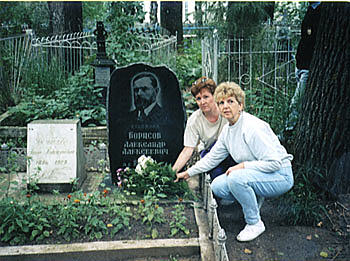 Jan Whitcomb (L) and Pauline Mayhew at the grave of Aleksandr Borisov. Photo by Jack Mayhew. |
One special visit we were able to make with fellow group members, Jan and Mike Whitcomb, was on the way to Turovets and Krasnoborsk, where we attended a reception at the Krasnoborsk museum. (Turovets and Krasnoborsk are two small towns on the Northern Dvina, 9 mi. and 32 mi. northwest of Kotlas, respectively.) Jan and Pauline were presented with flowers which they later put on the grave site of the Russian artist [Alexander] Borisov. They were the first Americans to be able to visit his grave.
![[Show table of contents & options]](../../questionsign.gif)
Another Russian cultural experience was a visit to a banya, which is the Russian version of a sauna. A banya is usually a one-room wooden building with a hole in the center of the floor and benches around the edge. The hole is filled with heated rocks. Cold water is poured onto the rocks and the resulting steam is used for cleansing. The men usually go in first when it is hottest and the women go in afterwards. Traditionally, birch branches are cut and tied together before going in and these are used to help stimulate the blood. One person generally lies flat while another person taps him with the birch tips. There is cold water to pour over you whenever you are too hot and you can either stay in or go out at this point. (At some banyas the participants go out and jump into a nearby lake or stream. In winter they may roll in the snow). At this one the women washed themselves and their hair before leaving. After the banya cups of tea and other liquids (to restore body fluids),salt pork, uncooked bacon, and fresh garlic, tomatoes and cucumbers are consumed.
We were able to visit the local kindergarten, which is like our daycare and pre-school combined. The children range in age from 1½ to 7 years. Each age group has its own room with 2 teachers. The children can be there from 6 a.m. to 7 p.m. In this particular kindergarten, there were 65 children in summer and 180 in winter. It cost only $1.00 a day for each child. See pictures of children at the kindergarten.
 Pauline Mayhew with her birthday cake. Photo by Jack Mayhew. |
Pauline had the unique opportunity to celebrate her birthday Russian-style. They did make her an American-style cake, complete with candles, and learned to sing "Happy Birthday" in English, but the rest of the celebration was Russian. Our hosts' twin nephews celebrated their birthdays on the same day, so all celebrated together. First Pauline sat on a chair, which the guests then lifted high into the air. For the children the chair was lifted up as many times as they were years old. (For the older people, it is lifted seven times.) Then the guests formed a circle around them and sang a typical Russian birthday song. After that they dropped hands and took away the chair. Then the celebrants had to pick "someone you love" to dance with. Children performed skits, and then we all had supper. During the meal one guest at a time would get up and return with gifts which he or she presented to Pauline. It was a wonderful evening and we danced until 2 a.m.
Our host family made a video of our visit and presented it to us as a farewell gift. It will enable us to relive all of our memorable moments. We are already looking forward to our next visit.
by Jack and Pauline Mayhew
For more pictures by Jack & Pauline Mayhew, see the photo displays "Music, Song, and Dance", "Children", and " People and Places".
![[Show table of contents & options]](../../questionsign.gif) |
Kotlas to Archangel by River Boat |
We depart momentarily from the recollections by members of the August delegation to share those of another traveler who visited Kotlas 1½ months earlier. Mason Smith of Cape Elizabeth, was in Russia for the last two weeks of June. He spent three days in Kotlas before taking a boat to Archangel.
A professional photographer, Smith's works have been exhibited widely, including in Archangel. He has traveled to northwestern Russia several times and has now published a 52-page book of black and white photographs taken during his trips there in 1994, 1995, and 1996.
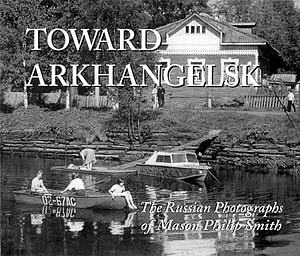 The cover of Mason Smith's book, Toward Arkhangelsk. |
Martial music blaring from her loudspeakers, the 261- foot, white-hulled Admiral Kuznetsov pulled way from the Kotlas River Station promptly at 5 p.m. on a fine June day for a 361-mile voyage to Archangel. Aboard were myself and Jerry French of Cape Elizabeth and approximately 40 Russian passengers. About half of the Russians rode all the way to Archangel, the rest disembarked at various villages en route.
Under the command of Captain Sergei Kulikov, the Kuznetsov boasted a crew of 25, ranging from deck officers and ordinary seamen to the young women who cleaned the cabins. Its passage determined by the amount of water in the sand-bar plagued Severnaya Dvina River, the vessel usually operates from mid-May to early July on a 40-hour trip. It is also possible to make the trip in 12 hours aboard a fast hydrofoil.
Our escort and guide for the trip was Irina Shubina, wife of Sasha Shubin. (Aleksandr "Sasha" Shubin is a school principal-turned-businessman who visited the Waterville area from January to May, 1995. Before going to Kotlas, Smith and French spent several days with Shubin in Yaroslavl, where he is regional representative for the M&M Mars Company.) Jerry and I occupied one cabin, and Irina slept in another, farther down the red-carpeted corridor that ran through the ship's center.
The trip cost us each $40, which did not include meals in the aft saloon. The dining room was closed the first evening, but the ever-resourceful Irina whipped up a fine meal of sausage, bread, and the ever-present cucumbers and tomatoes. Every meal thereafter we took in the dining saloon, where the prices ranged from $4.50 to $6.00 a person. Irina thought this was high; we thought it was more than reasonable for the quality and quantity.
Russian beer was available at a small ship's store just down the hall, as was Russian bottled water. Only a handful of Russian passengers ate in the dining area. Most preferred to eat their own food in their cabins. In addition, a few Russian passengers roamed the decks.
Shortly after leaving Kotlas, the Kuznetsov pulled alongside two large fuel barges and topped off her diesel tanks. As it was the season of the midnight sun, the vessel pulled up to the river bank each night for four hours rather than navigate through the sandbars in the diminished light. (From mid-June to early July, the days in Kotlas are more than 19 hours long, interrupted only by several hours of twilight. The sun just barely dips below the horizon, and the sky never really gets dark.)
In the forty hours that we were aboard, the Kuznetsov stopped at approximately 12 villages to discharge and board passengers. Usually there was a river boat station atop a large barge at the edge of the village, but in several cases a catwalk was swung over to the river bank, and the passengers went ashore by walking across it. At most river boat stations there were locals on hand to watch the "great white ship," as Irina called it, arrive and depart. At one mosquito-laden village, we stopped long enough for Irina, Jerry and me to go shore and walk the village streets, admiring the colorful log and brightly painted wooden houses.
One noon, the Captain pulled his vessel alongside the river bank so the crew could play a forty minute soccer game. When the whistle sounded, the players quickly posed for a team photograph and then scrambled back aboard, taking their goal posts with them.
Jerry and I spent most of our waking hours observing the river and countryside on the bridge, where the Captain served us tea from his personal samovar. His young son served as a cookie bearer. Later Captain Kulikov personally escorted us on a tour of the ship from the engine room to topside, ending in his paneled cabin where he presented us with the usual souvenir pins.
For the first 200 miles there was little other traffic on the Dvina. Twice, fast hydrofoils passed us, and once a small ferry crossed immediately in front of us. Later, we passed several small vessels pulling rafts of newly-cut logs. Nearing Archangel, the ship's foremast had to be lowered so the Kuznetsov could clear the large bridge from Archangel to the Isagorka-Severodvinsk highway.
Arriving at the Archangel river boat station, we were met by Sergei Stolov of the local Kodak franchise and Sasha's brother, Viktor Shubin. Several hours later the Kuznetsov sounded her whistle and then pulled into mid- stream to turn and head back to Kotlas on the next-to-last trips of her 1996 season. We spent four days in Archangel and then flew to St. Petersburg, where we spent several days before flying home via Amsterdam.
by Mason Philip Smith
![[Show table of contents & options]](../../questionsign.gif) |
Reflections on Glasnost |
Facing up to and dealing with injustices in your country's history isn't easy. It has taken us many generations to start talking openly about our treatment of the native Americans. It would seem to be even harder when it is a matter of the recent past, a past that many still remember.
Gorbachev took a bold step in declaring a policy of glasnost ("openness"). This opened the door to those who had long carried with them a strong sense of injustice to speak out. It also made it possible for the government to initiate some programs to try to compensate those who suffered. But it takes more time and patience to overcome the natural defense mechanisms that people built up during many years of totalitarian rule. Those who knew first-hand the injustice had had to protect themselves by silence or fall victim themselves. Many others who stood by silently had had to convince themselves of the justice of punishing "the enemies of the people." Even in a non-totalitarian society we have seen the same mechanisms at work in the history of our race relations.
My hostess on this visit to Kotlas, Irina Dubrovina, was one of those who spoke out quickly and surely. She had grown up in the gulag area where her father was exiled and she had had to hide the fact that he was an "enemy of the people" in order to attend the university. She was ready to risk going through the newly opened door, so she helped organize the local Kotlas group "Conscience".
This human rights organization has helped victims of the Stalinist repressions and their families get compensation from the government and has worked to uncover the misdeeds of the past and to educate the people of Kotlas about what happened in their area from the 1920's to the 1950's. I wasn't surprised, therefore, when one of the first things she wanted to show Phil Gonyar and me was the cross monuments she had helped a delegation of Poles erect, inscribed to the memory of the Poles, Russians, and others who had perished in forced labor camps in Kotlas and the surrounding area.
The first cross was placed in a small almost forgotten cemetery on the outskirts of Kotlas, near the railroad bridge over the Northern Dvina River. It was here that many of the builders of the bridge perished in the early days of World War II. Before the attack on Poland that precipitated the war, Hitler had signed a pact with Stalin and as the Germans moved in from the west, the Russians attacked Poland on the east, reclaiming Polish territory that the settlement of World War I had returned to the resurrected Polish state. Those who showed any opposition to their Russian occupiers were soon rounded up in whole families and sent to the gulags, many to the Archangel Region. When Hitler turned his forces on Russia and the coal-rich Donbas region fell, the Russians were forced to quickly make the coal fields of the Vorkuta area (northeast of Kotlas in the Komi Republic) available for the war effort. In the harsh conditions of the poorly developed North, the intensive work of building the rail lines (and the Kotlas bridge) cost the lives of many of those who had been forcibly removed to the area.
The second cross was in a cemetery closer to the center of Kotlas, which was carefully maintained by local school children. This was the site of a number of mass graves dating back to the 1920's. It was a sparsely wooded area interspersed with about a dozen distinct, but unmarked, mounds, each of which, Irina said, held numerous bodies.
![[Show table of contents & options]](../../questionsign.gif)
As Irina showed us these crosses, she told us that Kotlas had recently signed another sister city agreement, with the city of Tarnow in Poland. This made a deep impression on me. We had always avoided bringing up the gulags while in Kotlas. This new relationship, though undoubtedly based largely on the desire for contact on the part of ethnic Poles whose families had acclimated to life in Kotlas and chosen not to return to Poland, was one that was bound to constantly bring reminders of events that it would be much more comfortable to forget. It was a brave step of the local government to sign this agreement. To me this was a sign that glasnost was moving beyond a stage of permitting openness to one of living it.
This feeling was reinforced by several incidents during this trip. On my last trip four years ago my husband and I had spent a fair amount of time on trains and walking the streets of Moscow and St. Petersburg, where we had been exposed to ordinary Russians. We had made a point of interspersing some Russian into our conversations so that people would know they could communicate with us.
Although we found strangers polite and helpful if we asked them for something, we felt a certain restraint and lack of curiosity even in the cities which had had more exposure to foreigners. It was as if the years of trusting only those in your inner circle (and above all avoiding contact with foreigners, which could lead to an immediate visit from the secret police) had left a legacy of an inability to make active contact with the outer world. This was in sharp contrast to the warmth, hospitality and friendliness of those for whom some kind of tangible circumstances had given an opening to include us in their circle. This time, however, I found chance conversations occurred more freely, and in some cases conversations touched on things that would probably have been guarded carefully in the past.
Although benefits have been available for many years to people who could prove that they or their parents had suffered during the repressions and although economic circumstances would encourage anyone eligible to apply, it has been hard for many to come forward and claim these benefits. Little by little though, people are overcoming their hesitations and Irina reported she has had a constant stream of people seeking her help in locating the necessary paperwork to substantiate their claims. While I was there, Irina interviewed one such man.
A group of us also heard the story of one woman's family from her own lips. Our hearts went out to her as she told how her father had been sent to Kotlas as an "enemy of the people" merely because of his exposure to foreigners when he was taken prisoner by the Germans during the war. Then she told of her husband who had suffered the same fate after having been held and tortured by the Japanese. She seems to have come to terms with their fate and its effect on her own personal life and she told the tales with no sign of rancor.
But the encounter that made the biggest impression on me took place on a local train when we made a trip to a neighboring city. Irina, Phil, and I had sat on two bench seats facing each other and the fourth seat was taken by a Russian man. A conversation with him soon started up. I don't even remember what we discussed. He got off at the next station and as he left a young man who had been sitting diagonally behind us got up and asked Irina if he could join us. He said he couldn't help but overhear our conversation. At first he didn't address himself to Phil and me, but carried on a long conversation with Irina. I heard her ask him about himself. He seemed a little embarrassed at the question and answered in a quiet voice. I didn't catch the answer. They got into a rather extensive political discussion — he, a Communist, who recognized the Bolshevik regime as a distortion of his ideals, but who was dismayed at the uncontrolled speculation in the new market economy and the division of the country into rich and poor; and she, a true believer in democracy, who felt that with freedom they could work out the other problems. What struck me was that it was a real discussion, not an argument, with both treating each other with respect and both listening to what the other said. I could sense that he was a young man who was really questioning things and trying to make sense of the confusing world he was now living in. He got off the train before we did. After he left, Irina asked me if I had understood who he was. When she told me he worked in the Department of Internal Affairs, in other words, the police, I realized just how far Russia has come in the short time since glasnost was declared.
by Patricia Hanson
The following summer, Irina Dubrovina was Pat Hanson's guest in Oakland. See also "Kotlas and the Gulag" for more on that subject.
![[Show table of contents & options]](../../questionsign.gif) |
A Weekend In The Village |
My homestay was with Nikolai Sheptyakov. He was the newspaper reporter, some of you may remember, who came with the Kotlas delegation when they visited Waterville [in June 1990]. He now works at the railroad in an environmental engineering position. Nikolai may also be remembered for his articles in the Town Line, [a South China weekly, in 1993 and 1994.]
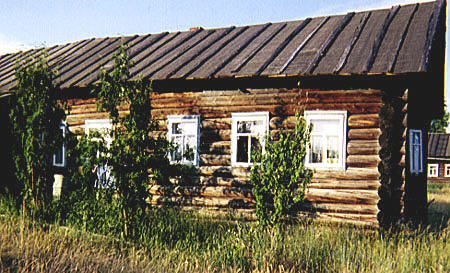 Nikolai Sheptyakov's ancestral home. Photo taken by Phil Gonyar on a return visit in July, 1999. |
We spent a weekend in the village in which Nikolai has a summer house. Now, a village in Russia can mean a small collection of houses in a remote area and that was the case with this one. There were 4 or 5 old houses and 3 new Russian dachas which could be reached through a woods road. Nikolai's log house has been in the family for generations and it is about 100 years old.
At 8:15 on a Saturday morning we left, in Nikolai's car, for a sightseeing venture. In the party were Pat Hanson, Kostic (Nikolai's teenaged son), Irina Dobrovina, Nikolai and I. Others would join us at the house. Our drive was through Koryazhma en route to Ilyinsk Podoma, a small town in which a friend of Nikolai's lives. We walked the main street, took in the view from the river bank and visited the local museum. The museum has, among other interesting artifacts, a small coin collection. Since it had no American coins, we left those we had with us. After a refreshment stop in a local cafe which had and used a huge samovar the likes of which I had never seen, we went on to the village of Plyosa.
This remote village has no electricity or plumbing. Nearby is a spring with water that has been tested as pure. Everyone in the village uses it. The Vilyed River is a few hundred yards from the house. Between the house and the river is a large field planted with some type of grain, the last remains of a kolkhov [collective farm] in the area. The woods surround the houses in the area and there are no year round residents. One elderly family comes in the spring and stays through the fall. Several owners rarely appear. Nikolai and the New Russians come most weekends in the planting season. [The New Russians are the people who are making big money from the change in the Russian economy; from government directed to private enterprise. People who develop in influence and money can afford to build new dachas and homes.] The major reason that the village is so important to Nikolai is because his garden is there. He has a huge potato planting ,a greenhouse with tomatoes, cucumbers and other delicate plants which demand a growing season longer than nature provides, berry bushes, and many other vegetables. In fact he grows enough potatoes to be able to sell some in the farmer's market back in Kotlas. Part of the payment for his car came from selling them.
The log house has a large kitchen and a main room. The attached shed, probably used for animals at one time, has a comfortable loft where the young members of the group sleep. He has added a garage and tool shed. The house is heated by a Russian fireplace/stove which his wife, Vala, uses for cooking. She cooks using the old utensils and methods with kerosene lanterns supplying the light.
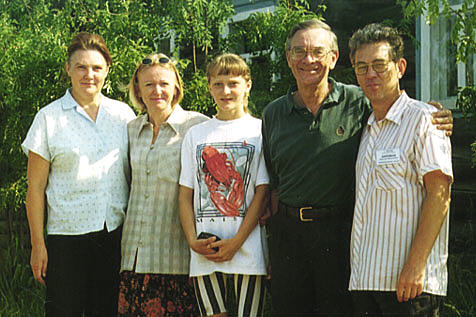 Valentina Sheptyakova, Lyuba Zinovkina, her daughter, Phil Gonyar, and Nikolai Sheptyakov outside the log house. Photo by Kostic Sheptyakov in July 1999. |
Nikolai's cousin and the boys went fishing for supper while he, Pat, Irina and I went to the woods for mushrooms. Vala and the cousin's wife picked berries and prepared the house and the food. Mushroom hunting isn't exactly easy since you need to know good from bad and extra special from just so. We were introduced to the wild berries, the flora and fauna (of which we saw none) of the Russian forest. On the way we examined the other old houses which are made in a variety of architectural styles. Coming back we gathered bits of wood for the fire. The fishing, using a home-made stunner,had been successful. Our mushroom hunting resulted in a goodly number; however when I asked for an evaluation of our efforts Nikolai said that if he'd been alone he would have gathered twice as many and of better quality. Oh well, so much for my talents in the woods!
Food cooked in the old Russian way is tasty and substantial. Fish and mushroom soup, stew, vegetables and cheese, vegetable and mushroom pizza were among the items in the feast. After playing a vigorous game of Yahtzee by kerosene light we were ready to sleep.
Sunday dawned bright so we took another trek into the woods. When we came to the river Nikolai fished for a while and caught 4 of the tiniest fish I have ever seen. He said that 40 of them would make a good meal but we didn't have time to catch that many. On this trip to the forest we went into the bog to see the extreme boundaries of it. We gathered a few more mushrooms and went back to the house where I got a lesson on the Russian banya. Having already had the banya experience, I passed. Then we met the New Russian neighbors who were interested in pictures that I had with me of my house and car.
At dusk it was time to return to Kotlas. Woods roads are no place to be in the dark. When we arrived home about 9:30 pm, Kostic was most anxious for me to go to bed so he could go out with his friends (a girl friend, I believe). Since he knew the only English in the house, his parents expected him to stay close in case I had a verbal communication need. I was ready to sleep but we hadn't had tea yet. It is an evening ritual. This completed, I retired to contemplate another extraordinary Russian experience.
by Phil Gonyar
If you haven't already looked at them, be sure to check out our photo essays: "Music, Song, and Dance", "Children", and " People and Places".
Newsletter Credits: Vivian Tinner edited the print edition of this issue and Greg Smith prepared the online version. Thanks to Phil Gonyar, Pat Hanson, Mary Coombs, Jack & Pauline Mayhew, and Mason Philip Smith for their written reminiscences and to Jack & Pauline Mayhew, Earl & Mary Coombs, and Phil Gonyar for the photographs.